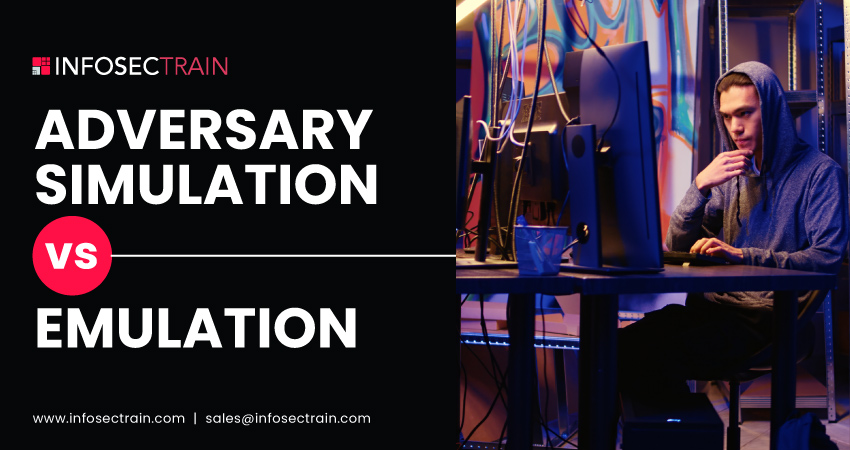Adversary Simulation vs. Emulation
The ongoing growth of cyber threats presents severe challenges for organizations everywhere in the current digital era. To defend against these threats effectively, organizations use various cybersecurity practices. Among these, adversary simulation and emulation are essential cybersecurity practices that enhance an organization’s security posture by proactively identifying and addressing vulnerabilities and weak points in its network defenses.

These techniques include simulating cyber attacks and imitating the behaviors of threat actors to assess an organization’s defenses, response capabilities, and incident detection mechanisms. Although these terms sound similar, they actually have different purposes and are essential for enhancing an organization’s cybersecurity posture. In this article, we will delve into the differences between adversary simulation and adversary emulation.
What is Adversary Simulation?
Adversary simulation is a comprehensive cybersecurity assessment that evaluates an organization’s preparedness and responsiveness to various cyber threats and incidents. The approach involves testing detection, response, and recovery procedures as well as replicating real-world scenarios. It helps organizations identify weaknesses and vulnerabilities and improve their defenses, ensuring they can effectively safeguard against and prevent the impact of cyber attacks.
What is Adversary Emulation?
Adversary emulation is a targeted cybersecurity practice where security professionals, known as red teams, imitate real-world threat actors’ Tactics, Techniques, and Procedures (TTPs). This approach involves replicating the tactics and behavior of malicious actors to infiltrate an organization’s network or systems. It helps identify and analyze vulnerabilities and flaws within the defenses by simulating how malicious actors might attempt to compromise the organization’s security, providing actionable insights for enhancing security measures.
Adversary Simulation vs. Emulation: What’s the Difference?
Here is a comparison between adversary simulation and adversary emulation:
| Aspect | Adversary Simulation | Adversary Emulation |
| Purpose | Test overall cybersecurity readiness and response capabilities by simulating various cyberattack scenarios | Imitate the Tactics, Techniques, and Procedures (TTPs) of actual threat actors to identify vulnerabilities, misconfigurations, or gaps in security controls |
| Methodology | Involves scenario-based exercises where teams respond to hypothetical or real-world cyber incidents, evaluating coordination and response procedures | Involves security professionals (red teams) attempting to imitate the behavior of actual threat actors, using tools, techniques, and strategies employed by attackers |
| Focus | Evaluating and improving incident response, coordination, communication, and the organization’s ability to manage cyber incidents effectively | Testing the effectiveness of existing security measures and identifying vulnerabilities in the network or systems |
| Frequency | Conducted periodically, such as annually or semi-annually, or in response to the threat landscape changes | Often conducted more frequently as part of routine security assessments or penetration tests |
| Outcome | Provides insights into the organization’s overall cybersecurity posture and readiness to handle cyber threats and incidents | Generates detailed findings related to vulnerabilities, weaknesses, misconfigurations, or gaps in security controls, which can be used for remediation |
| Use Cases | Commonly used in various cybersecurity activities, including incident response drills, cybersecurity awareness training, tabletop exercises, full-scale scenario simulations, and evaluating the effectiveness of an organization’s incident response plan | Commonly used in vulnerability assessments and penetration testing to identify vulnerabilities in an organization’s security defenses that threat actors could exploit |
Adversary Simulation vs. Emulation: Which One to Choose?
If you want to simulate real-world threat tactics and find vulnerabilities in your organization’s network and defenses, then adversary emulation is the best approach. It is focused on testing your security controls against specific attack scenarios. On the other hand, adversary simulation is a more comprehensive approach that includes various cybersecurity exercises beyond emulation, such as incident response drills and tabletop exercises. Ultimately, the choice depends on specific goals: emulation for vulnerability discovery and simulation for holistic readiness assessment.
You can also consider both approaches for a comprehensive cybersecurity strategy that not only addresses their particular vulnerabilities but also prepares them for a wide range of cyberattacks.
How can InfosecTrain Help?
To better understand adversary simulation and emulation, consider enrolling in InfosecTrain’s Advanced Penetration Testing training course. This course emphasizes the mastery of advanced penetration testing techniques. With the guidance of our certified and experienced instructors, you will acquire valuable insights into these practices. They will guide you through the learning journey, equipping you with practical knowledge and skills to excel in cybersecurity and perform comprehensive penetration tests effectively.
TRAINING CALENDAR of Upcoming Batches For APT with KALI Linux
| Start Date | End Date | Start - End Time | Batch Type | Training Mode | Batch Status | |
|---|---|---|---|---|---|---|
| 04-May-2025 | 21-Jun-2025 | 09:00 - 13:00 IST | Weekend | Online | [ Open ] |







 1800-843-7890 (India)
1800-843-7890 (India)